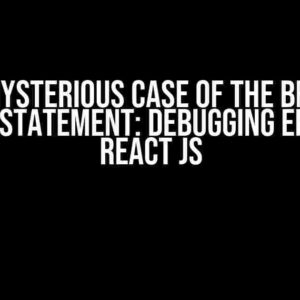Are you tired of dealing with complex dependency management in your Java Primefaces projects? Do you struggle to understand how to effectively use Managed Beans to simplify your development process? Look no further! In this article, we’ll take you on a journey to master the art of Java Primefaces Dependency Managed Bean management.
What is a Managed Bean in Java Primefaces?
In Java Primefaces, a Managed Bean is a Java class that is instantiated and managed by the JavaServer Faces (JSF) framework. It’s a powerful tool that allows you to separate your application logic from your presentation layer, making it easier to maintain and update your code. Managed Beans are typically used to handle user input, perform business logic, and interact with the Primefaces UI components.
Benefits of Using Managed Beans
- Improved code organization and structure
- Easier maintenance and updates
- Enhanced scalability and flexibility
- Better separation of concerns between presentation and business logic
Configuring a Managed Bean in Primefaces
To create a Managed Bean in Primefaces, you’ll need to follow these simple steps:
- Create a new Java class with a public constructor and a @ManagedBean annotation:
- Declare the Managed Bean in your faces-config.xml file:
- Use the Managed Bean in your Primefaces UI components:
@ManagedBean
public class MyManagedBean {
public MyManagedBean() {}
}
<managed-bean>
<managed-bean-name>myManagedBean</managed-bean-name>
<managed-bean-class>com.example.MyManagedBean</managed-bean-class>
<managed-bean-scope>view</managed-bean-scope>
</managed-bean>
<h:inputText value="#{myManagedBean.property}"/>
Dependency Injection with Primefaces
One of the most powerful features of Primefaces is its support for Dependency Injection (DI). With DI, you can easily inject Managed Beans, EJBs, and other resources into your Primefaces UI components.
Types of Dependency Injection
- @ManagedProperty: injects a Managed Bean property into another Managed Bean
- @Inject: injects a resource, such as an EJB or a database connection
- @FacesComponent: injects a Primefaces UI component
Let’s take a closer look at how to use @ManagedProperty to inject a Managed Bean property:
@ManagedBean
public class MyManagedBean {
@ManagedProperty(value = "#{anotherManagedBean.property}")
private String injectedProperty;
// getters and setters
}
Best Practices for Managed Bean Dependency Management
To get the most out of your Managed Bean dependency management, follow these best practices:
- Keep your Managed Beans lightweight and focused on a single task
- Avoid complex dependencies and circular dependencies
- Use interfaces and abstract classes to decouple your dependencies
- Use a consistent naming convention for your Managed Beans and dependencies
Common Pitfalls to Avoid
When working with Managed Bean dependency management, it’s easy to fall into some common pitfalls. Here are a few to watch out for:
- Over-injecting dependencies: avoid injecting unnecessary dependencies that can lead to tight coupling and complexity
- Under-injecting dependencies: make sure to inject all necessary dependencies to avoid errors and exceptions
- Misusing scopes: ensure that you’re using the correct scope for your Managed Bean and dependencies
Real-World Example: User Registration with Primefaces and Managed Beans
Let’s put what we’ve learned into practice with a real-world example. We’ll create a simple user registration system using Primefaces and Managed Beans.
| Component | Managed Bean | Description |
|---|---|---|
| Username input field | RegistrationManagedBean | Handles user input for username |
| Password input field | RegistrationManagedBean | Handles user input for password |
| Register button | RegistrationManagedBean | Triggers the registration process |
| Registration service | RegistrationServiceManagedBean | Handles the registration process and database interaction |
In this example, we have two Managed Beans: RegistrationManagedBean and RegistrationServiceManagedBean. The RegistrationManagedBean handles user input and interactions with the UI components, while the RegistrationServiceManagedBean handles the registration process and database interaction.
@ManagedBean
public class RegistrationManagedBean {
@ManagedProperty(value = "#{registrationServiceManagedBean}")
private RegistrationServiceManagedBean registrationService;
private String username;
private String password;
public void register() {
registrationService.registerUser(username, password);
}
// getters and setters
}
@ManagedBean
public class RegistrationServiceManagedBean {
@Inject
private UserDAO userDAO;
public void registerUser(String username, String password) {
userDAO.createUser(username, password);
}
}
Conclusion
Mastering Java Primefaces Dependency Managed Bean management is a crucial step in building robust, scalable, and maintainable applications. By following the best practices and guidelines outlined in this article, you’ll be well on your way to creating efficient and effective Managed Beans that simplify your development process.
Remember to keep your Managed Beans lightweight, focused, and decoupled from your presentation layer. Use Dependency Injection to inject necessary resources and avoid common pitfalls like over-injecting and under-injecting dependencies.
With practice and patience, you’ll become a master of Java Primefaces Dependency Managed Bean management, and your applications will reap the benefits of this powerful technology.
Here are 5 questions and answers about “Java Primefaces Dependency Managed Bean” in a creative tone:
Frequently Asked Question
Get the scoop on Java Primefaces Dependency Managed Bean with these frequently asked questions!
What is a Managed Bean in Primefaces?
A Managed Bean is a Java class that is managed by the JavaServer Faces (JSF) framework. It’s a simple Java class that contains properties and methods that can be accessed from a Primefaces application. Think of it as a container for your application’s data and business logic!
How do I create a Managed Bean in Primefaces?
Easy peasy! To create a Managed Bean, you simply need to annotate a Java class with the @ManagedBean annotation, and make sure it’s in a scanned package. You can also specify the bean’s scope, such as @SessionScoped or @RequestScoped, depending on your application’s needs.
What is the purpose of the @Dependency annotation in Primefaces?
The @Dependency annotation is used to inject dependencies into a Managed Bean. It allows you to declare a dependency on another Managed Bean, which can then be injected into your bean at runtime. This is super useful for decoupling your application’s components and promoting a more modular design!
Can I use multiple Managed Beans in a single Primefaces application?
Absolutely! You can have as many Managed Beans as you need in a Primefaces application. Each bean can be used to manage a specific part of your application’s logic, and they can even communicate with each other using the @Dependency annotation. The more, the merrier!
How do I access a Managed Bean from a Primefaces component?
You can access a Managed Bean from a Primefaces component using the EL (Expression Language) syntax. For example, if you have a Managed Bean called “myBean” with a property called “myProperty”, you can access it in your Primefaces component using #{myBean.myProperty}. Simple, right?






